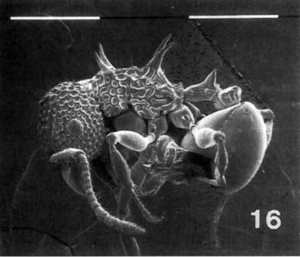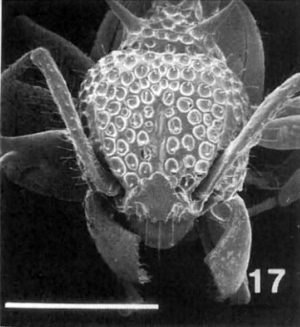Acanthomyrmex sulawesiensis
| Acanthomyrmex sulawesiensis | |
|---|---|

| |
| Scientific classification | |
| Kingdom: | Animalia |
| Phylum: | Arthropoda |
| Class: | Insecta |
| Order: | Hymenoptera |
| Family: | Formicidae |
| Subfamily: | Myrmicinae |
| Tribe: | Crematogastrini |
| Genus: | Acanthomyrmex |
| Species group: | luciolae |
| Species: | A. sulawesiensis |
| Binomial name | |
| Acanthomyrmex sulawesiensis Terayama, Ito & Gobin, 1998 | |
Colonies nest in downed twigs on the forest floor. In A. sulawesiensis, the colony size was also around 30 workers, a few of which were majors. Ergatoid queens and majors of had two ovarioles per ovary, while minors had only one. A colony kept in the lab for a few months produced many ergatoid queens. up to 15 just after orphaning. In this orphaned colony, newborn ergatoid queens started to leave the nest to climb onto the top of elevated surfaces and perform sexual calling behavior. This is a posture in which the abdomen is lifted high in the air, with the sting slightly extruded. Unfortunately, no males were available to test the attractiveness of the queens. (Terayama et al. 1998)
Identification
Terayama et al. (1998) - This species is similar to Acanthomyrmex basispinosus from Sulawesi, in having the propodeal spines with a wide basal portion. However, it is easily distinguished from the latter by the straight posterior margin of head in minors (strongly concave in basispinosus), the much broader head (CI > 120, whereas CI < 105 in basispinosus), and the higher petiolar node with acute spines at apex in minor and major workers (short and without spines in basispinosus).
Keys including this Species
Distribution
Distribution based on Regional Taxon Lists
Indo-Australian Region: Indonesia (type locality), Sulawesi.
Distribution based on AntMaps
Distribution based on AntWeb specimens
Check data from AntWeb
Countries Occupied
| Number of countries occupied by this species based on AntWiki Regional Taxon Lists. In general, fewer countries occupied indicates a narrower range, while more countries indicates a more widespread species. |

|
Estimated Abundance
| Relative abundance based on number of AntMaps records per species (this species within the purple bar). Fewer records (to the left) indicates a less abundant/encountered species while more records (to the right) indicates more abundant/encountered species. |

|
Biology
- Queen type: ergatoid (Terayama et al. 1998, Yamada et al. 2018) (ergatoid minor-like)
Castes
Worker
Minor
 
| |
| Worker (minor). Photographer Terayama et al., 1998. | |
Queen
 
| |
| Queen (ergatoid). Photographer Terayama et al., 1998. | |
Nomenclature
The following information is derived from Barry Bolton's Online Catalogue of the Ants of the World.
- sulawesiensis. Acanthomyrmex sulawesiensis Terayama, Ito & Gobin, 1998: 262, figs. 13-18, 25-27 (s.w.q.) INDONESIA (Sulawesi).
- Type-material: holotype major worker, 5 paratype minor workers, 5 paratype ergatoid queens.
- Type-locality: holotype Indonesia: Sulawesi, Kobupoke-Maros, Karaenta, 18.iii.1996 (B. Gobin); paratypes with same data.
- Type-depositories: BZBC (holotype); BZBC, MNHA, NIAS (paratypes).
- Status as species: Yamada, Ito, et al. 2018: 10.
- Distribution: Indonesia (Sulawesi).
Description
Worker
Major. (holotype). HL 2.48 mm; HW 2.40 mm; SL 1.10 mm; CI 97; SI 46; WL 1.13 mm; PL 0.53 mm; PH 0.45 mm; DPW 0.27 mm; PPL 0.29 mm; PPH 0.43 mm; PPW 0.45 mm; TL 5.0 mm.
Head as long as wide, with concave posterior margin in fun face view; cephalic median hurrow developed, but very weak on vertex; frons and vertex subopaque and moderately punctate, with short erect hairs sparsely; punctures shallow, 0.05-0.13 mm in diameter, and separated by 1.0-1.2 X their diameters. Mandible subopaque, without distinct tooth. Anterior margin of clypeus weakly produced medially, and very weakly concave at midlength. Antennal scape with marc than 15 erect hairs; 2nd segment longer than wide; 3rd and 4th segments each slightly longer than wide; 5th to 9th segments each as long as wide. Antennal scrobe shallow, without funicular scrobe. Eye 0.25 mm in diameter.
Pronotum with punctures which are 0.05-0.08 mm in diameter; propodeal spine in profile straight, with a wide basal portion relatively abruptly narrowing to shaft of spine; length 0.50 mm; propodeal declivitous surface smooth and shining.
Petiole 1.18 X as long as high, with high and thin node; dorsum with 2 pairs of erect hairs; one near the top of node and the other in posterodorsal portion; lateral petiolar hairs present; in posterior view, dorsum with a pair of acute teeth as in Fig. 25. Postpetiole 0.67 X as long as wide, with 3 pairs of relatively short erect hairs dorsally; 2 pairs of lateral postpetiolar hairs present; dorsal margin convex, and highest at anterior 1/3 of its length; in dorsal view, postpetiole 0.5 X as long as wide and dorsal disc 0.41 X as long as wide.
Gaster subopaque and weakly shining excepting the anterior 1/3 of 1st tergite, with shallow sparse punctures, and scattered with erect hairs.
Body reddish brown, gaster darker; clypeus blackish brown; mandibles reddish brown excepting the masticatory and basal margines blackish brown; antennae and legs brown.
Minor. HL 1.01 mm; HW 1.28 mm; SL 1.08 mm; Cl 127; SI 84; WL 1.15 mm; PL 0.45 mm; PH 0.38 mm; DPW 0.26 mm; PPL 0.23 mm; PPH 0.36 mm; PPW 0.38 mm; TL 4.0 mm.
Head wider than long, with almost straight, very weakly convex posterior margin in full face view; frons and vertex coarsely punctate; the punctures large, 0.09-0.10 mm in diameter. Mandible subopaque. Clypeus without 2 longitudinal rugae; medial clypeal lobes very weakly developed; clypeal index 83. Eye 0.20 mm in diameter.
Pronotum with coarse punctures which are 0.06-0.09 mm in diameter; pronotal spine long, 0.53 mm long; mesonotal dorsum straight in profile; propodeal spine long with a wide base, and subequal in length to pronotal teeth.
Petiole 1.18 X as long as high, with high and thin node in profile; in posterior view, a pair of acute teeth present on posterolateral corners of node as in Fig. 26. Postpetiole 0.64 X as long as high, with convex dorsal margin in profile; dorsum with 3 pairs of erect hairs; 2 lateral postpetiolar hairs present; in dorsal view, postpetiole 0.55 X as long as wide, and dorsal disc 0.34 X as long as wide.
Gaster shagreened, with erect hairs.
Body reddish brown, gaster even darker; mandibles, antennae, and legs brown, somewhat yellowish.
Queen
Ergotoid queen. HL 1.13 mm; HW 2.50 mm; SL 1.15 mm; CI 122; SI 84; WL 1.00 mm; PL 0.45 mm; PH 0.43 mm; DPW 0.27 mm; PPL 0.23 mm; PPH 0.45 mm; PPW 0.43 mm; TL 4.0 mm.
General shape as in minor workers with the following differences: pronotal spines distinctly shorter than propodeal spines; mesanotal dorsum with a large transverse carina; propodeal spines with much broader base.
Type Material
Holotype. Major worker, Karaenta, KobupokeMaros, Sulawesi, Indonesia, 18.111.1996, B. Gobin leg. Paratypes. 5 minor workers. 5 ergatoid queens. Same colony as holotype.
Etymology
The specific epithet refers to the type locality.
References
- Terayama, M., Ito, F. ; Gobin, B. 1998. Three new species of the genus Acanthomyrmex Emery (Hymenoptera: Formicidae) from Indonesia, with notes on the reproductive caste and colony composition. Entomol. Sci. 1: 257-264. (page 262, figs. 13-18, 25-27 soldier, worker, queen described)
- Yamada, A., Ito, F., Hashim, R. and K. Eguchi. 2018. Queen polymorphism in Acanthomyrmex careoscrobis Moffett, 1986 in Peninsular Malaysia (Hymenoptera: Formicidae: Myrmicinae), with descriptions of hitherto unknown female castes and males. Asian Myrmecology. 10:e010009:1-14. doi:10.20362/am.010009
References based on Global Ant Biodiversity Informatics
- Terayama M., F. Ito, and B Gobin. 1998. Three new species of the genus Acanthomyrmex Emery (Hymenoptera: Formicidae) from Indonesia, with notes on the reproductive caste and colony composition. Entomological Science 1: 257-264.
